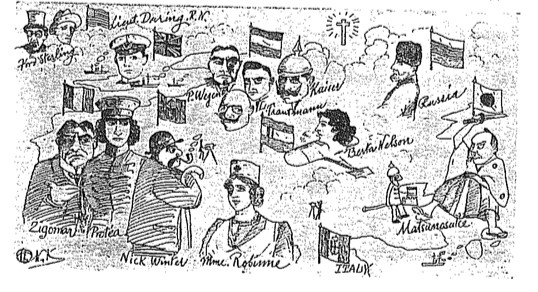Montag, 16. Januar 2017, 18:30 - 20:00 iCal
Ogawa Sawako, Taniguchi Norie
The First World War and Japanese Cinema: The Tracks of Forgotten Images
Dokus? in 1917 Japanese Cinema: Popularity of rensageki and the Nikkatsu Muk?jima Film Studio
Institut für Ostasienwissenschaften - Japanologie, Seminarraum JAP 1
UniversitätsCampus Hof 2, Eingang 2.4, Spitalgasse 2, 1090 Wien
Vortrag
The First World War and Japanese Cinema: The Tracks of Forgotten Images
Like other fields of study film history too considered the First World War as the forgotten war. However, at the time of WWI itself many films on the war, both documentaries and feature films, were regularly screened in Japan. In this paper, I introduce what kinds of WWI films were released and spread all over Japan during the wartime. Further, I explicate how the propaganda film system was formed and how the distinction between facts, fiction and fake was introduced. Lastly, I argue the shift in hegemonic influence on Japanese modern culture and cinema from European cinema to Hollywood cinema.
Sawako Ogawa is an Assistant Professor of Film and Theatre Arts at the Institute for Research in Humanities at Kyoto University. She obtained her PhD in 2012 in Film and Theater Studies at Waseda University. The findings of her dissertation were published in the monograph Eiga no taid?: 1910 nendai no hikakueigashi (Early Stage of Cinema: A Comparative Film History of the 1910s) with Jinbunshoin in 2016.
Dokus? in 1917 Japanese Cinema: Popularity of rensageki and the Nikkatsu Muk?jima Film Studio
The novel Dokus? (Poisonous Plant, 1916) by Kikuchi Y?h? was serialized in newspapers and adapted into film, theater, and rensageki (chain drama, a drama that mixes theater and film on stage)—all of which opened on the same day. It was common for both film and theater dramas to open at the same time; however, it was remarkable that Dokus? was used not only in film and shinpa, (new school theater) but also in rensageki, kugeki (classical drama), and even in comedy plays in the same period. This paper examines the characteristic feature of the Nikkatsu Muk?jima Film Studio through their production of Dokus?, focusing on the circumstances of each theater opening, which exactly represented the distinguishing characteristics of each studio.
This paper also ascertains how the participation of Inoue Masao, a star actor of rensageki, encouraged the development of Japanese theater and cinema. After this period Japanese cinema changed drastically, adopting a production style influenced by American cinema. However, Nikkatsu Muk?jima developed a unique cinema style, retaining its individual characteristics.
Taniguchi Norie is a fellow of the Japan Society for Promotion of Science. She graduated from City University of New York in Cinema Studies and obtained her PhD at Wadeda University. The title of her thesis is “A Study of Nikkatsu Mukojima Studios’ Shinpa Film”.
Veranstalter
Institut für Ostasienwissenschaften/Japanologie und AAJ (Akademischer Arbeitskreis Japan)
Kontakt
Mag. Angela Kramer
Universität Wien
Institut für Ostasienwissenschaften - Japanologie
4277-43801
angela.kramer@univie.ac.at
Erstellt am Dienstag, 10. Januar 2017, 12:21
Letzte Änderung am Mittwoch, 11. Januar 2017, 08:51

